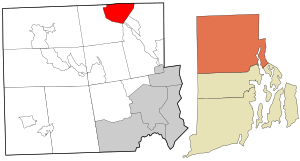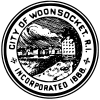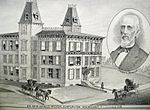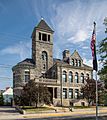Woonsocket, Rhode Island facts for kids
Quick facts for kids
Woonsocket
|
||
|---|---|---|
| City of Woonsocket | ||

Woonsocket's city hall
|
||
|
||
| Motto(s):
"A City on the Move"
|
||

Location in Providence County and the state of Rhode Island
|
||
| Country | ||
| State | ||
| County | Providence | |
| Incorporated (town) | 1867 | |
| Incorporated (city) | 1888 | |
| Government | ||
| • Type | Mayor-council | |
| Area | ||
| • Total | 7.93 sq mi (20.55 km2) | |
| • Land | 7.75 sq mi (20.06 km2) | |
| • Water | 0.19 sq mi (0.48 km2) | |
| Elevation | 194 ft (59 m) | |
| Population
(2020)
|
||
| • Total | 43,240 | |
| • Density | 5,582.24/sq mi (2,155.42/km2) | |
| Time zone | UTC−5 (Eastern) | |
| • Summer (DST) | UTC−4 (Eastern) | |
| ZIP Code |
02895
|
|
| Area code(s) | 401 | |
| FIPS code | 44-80780 | |
| GNIS feature ID | 1219339 | |
| Website | www.woonsocketri.org | |
Woonsocket is a city in Providence County, Rhode Island, United States. It is the sixth largest city in the state, with about 43,240 people living there in 2020. Woonsocket is Rhode Island's northernmost city. It is located just south of the Massachusetts state line. The city is part of the larger Providence metropolitan area.
Woonsocket is home to the main office of CVS Health, a big company that provides pharmacy services. You can also find Landmark Medical Center and the Museum of Work and Culture here. The American-French Genealogical Society is also located in Woonsocket.
Contents
History of Woonsocket
Before European settlers arrived in the 1600s, the Woonsocket area was home to three Native American tribes. These were the Nipmuc, Wampanoag, and Narragansett tribes. In 1661, Roger Williams bought the land from the "Coweset and Nipmucks." He called the area Niswosakit in a letter.
The name "Woonsocket" might come from other Native American names. For example, Woonksechocksett means "fox country." Wannashowatuckqut means "at the fork of the river." Another idea is that the city was named after Woonsocket Hill in nearby North Smithfield.
How Woonsocket Grew into a City
Woonsocket Falls Village started in the 1820s. It grew quickly during the Industrial Revolution. The Blackstone River provided lots of water power. This made the area perfect for textile mills. In 1831, Edward Harris built his first textile mill in Woonsocket.
Woonsocket became a town in 1867. Three villages from the town of Cumberland joined together. These were Woonsocket Falls, Social, and Jenckesville. In 1871, three more industrial villages from Smithfield were added. These were Hamlet, Bernon, and Globe. This created the city's current borders. Woonsocket officially became a city in 1888.
Immigration and Culture
The growth of factories brought many immigrants to Woonsocket. Most of them were Québecois and French-Canadians. In 1899, a group called the Union Saint-Jean-Baptiste d’Amérique chose Woonsocket for its main office. This was because many French-Canadians lived in the area.
By 1913, Woonsocket had one of the largest populations of French or French-Canadian people in the country. By the time the local textile industry closed during the Great Depression, about 75 percent of the people were French-Canadian. French newspapers were printed, and many people spoke French in public. Even in 1980, 70% of Woonsocket's population had French-Canadian roots.
Woonsocket in the 20th Century
During the Great Depression, Woonsocket's textile factories almost stopped working. But the economy got better during World War II. The city became a big center for making fabric for the war, including military uniforms.
After the war, Woonsocket's economy changed. Manufacturing decreased, and other businesses grew. These included retail stores, technology, and financial services. In the early 1980s, Woonsocket faced high unemployment.
Since 1979, Woonsocket has hosted Autumnfest. This is an annual cultural festival that happens on Columbus Day weekend. It takes place at World War II Veteran's Memorial State Park. It is one of the city's most popular events.
Geography and Climate
Woonsocket covers about 8.0 square miles (20.5 square kilometers). Most of this is land, and a small part is water. The Blackstone River flows through Woonsocket.
The city is next to Blackstone and Bellingham in Massachusetts. It also borders Cumberland and North Smithfield in Rhode Island.
Woonsocket's Weather
Woonsocket has a humid continental climate. This means it has four clear seasons. Winters can be cold, with warm days and very cold nights. Summers are usually warm and humid.
| Climate data for Woonsocket, Rhode Island (1991–2020 normals, extremes 1967–present) | |||||||||||||
|---|---|---|---|---|---|---|---|---|---|---|---|---|---|
| Month | Jan | Feb | Mar | Apr | May | Jun | Jul | Aug | Sep | Oct | Nov | Dec | Year |
| Record high °F (°C) | 71 (22) |
73 (23) |
82 (28) |
96 (36) |
97 (36) |
97 (36) |
101 (38) |
102 (39) |
97 (36) |
86 (30) |
80 (27) |
73 (23) |
102 (39) |
| Mean daily maximum °F (°C) | 37.8 (3.2) |
39.9 (4.4) |
47.3 (8.5) |
59.8 (15.4) |
69.9 (21.1) |
78.5 (25.8) |
84.0 (28.9) |
82.5 (28.1) |
75.4 (24.1) |
63.9 (17.7) |
53.4 (11.9) |
43.0 (6.1) |
61.3 (16.3) |
| Daily mean °F (°C) | 28.3 (−2.1) |
30.5 (−0.8) |
37.8 (3.2) |
48.9 (9.4) |
58.9 (14.9) |
67.9 (19.9) |
73.6 (23.1) |
72.1 (22.3) |
64.9 (18.3) |
52.9 (11.6) |
43.3 (6.3) |
33.8 (1.0) |
51.1 (10.6) |
| Mean daily minimum °F (°C) | 18.8 (−7.3) |
21.1 (−6.1) |
28.2 (−2.1) |
38.0 (3.3) |
47.9 (8.8) |
57.3 (14.1) |
63.3 (17.4) |
61.7 (16.5) |
54.4 (12.4) |
42.0 (5.6) |
33.2 (0.7) |
24.6 (−4.1) |
40.9 (4.9) |
| Record low °F (°C) | −8 (−22) |
−11 (−24) |
−2 (−19) |
18 (−8) |
26 (−3) |
38 (3) |
44 (7) |
43 (6) |
29 (−2) |
18 (−8) |
9 (−13) |
0 (−18) |
−11 (−24) |
| Average precipitation inches (mm) | 4.37 (111) |
3.67 (93) |
4.89 (124) |
4.71 (120) |
3.64 (92) |
4.26 (108) |
3.62 (92) |
4.01 (102) |
4.17 (106) |
5.08 (129) |
4.22 (107) |
5.27 (134) |
51.91 (1,319) |
| Average snowfall inches (cm) | 12.3 (31) |
10.7 (27) |
7.6 (19) |
1.9 (4.8) |
0.0 (0.0) |
0.0 (0.0) |
0.0 (0.0) |
0.0 (0.0) |
0.0 (0.0) |
0.1 (0.25) |
1.0 (2.5) |
7.9 (20) |
41.5 (105) |
| Average precipitation days (≥ 0.01 in) | 11.5 | 10.1 | 10.9 | 11.9 | 12.8 | 11.4 | 10.7 | 10.3 | 10.1 | 11.4 | 10.2 | 11.2 | 132.5 |
| Average snowy days (≥ 0.1 in) | 5.2 | 4.3 | 2.7 | 0.4 | 0.0 | 0.0 | 0.0 | 0.0 | 0.0 | 0.0 | 0.5 | 3.0 | 16.1 |
| Source: NOAA | |||||||||||||
People of Woonsocket
| Historical population | |||
|---|---|---|---|
| Census | Pop. | %± | |
| 1870 | 11,527 | — | |
| 1880 | 16,050 | 39.2% | |
| 1890 | 20,830 | 29.8% | |
| 1900 | 28,204 | 35.4% | |
| 1910 | 38,126 | 35.2% | |
| 1920 | 43,496 | 14.1% | |
| 1930 | 49,376 | 13.5% | |
| 1940 | 49,303 | −0.1% | |
| 1950 | 50,211 | 1.8% | |
| 1960 | 47,080 | −6.2% | |
| 1970 | 46,820 | −0.6% | |
| 1980 | 45,914 | −1.9% | |
| 1990 | 43,877 | −4.4% | |
| 2000 | 43,224 | −1.5% | |
| 2010 | 41,186 | −4.7% | |
| 2020 | 43,240 | 5.0% | |
| U.S. Decennial Census | |||
Population Facts (2020)
In 2020, Woonsocket had 43,240 people living in 18,287 households. About 27.8% of households had children under 18. The average household had 2.5 people.
About 21.9% of the population was under 18 years old. About 14.5% were 65 years or older. The median age was 37.2 years.
Arts and Culture
Historic Places to Visit
Many buildings and areas in Woonsocket are listed on the National Register of Historic Places. This means they are important historical sites. Here are some of them:
- 1761 Milestone
- Allen Street Historic District
- Alphonse Gaulin Jr. House (1885)
- Bernon Worsted Mill (1919)
- Cato Hill Historic District
- Frank Wilbur House (1923)
- Glenark Mills (1865)
- Grove Street Elementary School (1876)
- Hanora Mills (1827)
- Harris Warehouse (1855)
- Henry Darling House (1865)
- Honan's Block and 112-114 Main Street (1879)
- Hope Street School (1899)
- Island Place Historic District
- Jenckes Mansion (1828)
- John Arnold House (1712)
- L'Eglise du Precieux Sang (1873)
- Linton Block (1888)
- Logee House (1729)
- Main Street Historic District
- North End Historic District
- Philmont Worsted Company Mill (1919)
- Pothier House (1881)
- Smith-Ballou House (1906)
- Smithfield Friends Meeting House, Parsonage and Cemetery (1719/1881)
- South Main Street Historic District
- St. Andrews Episcopal Chapel (1894)
- St. Ann's Church Complex (1913)
- St. Charles Borromeo Church Complex (1867)
- Stadium Building (1925)
- Union Village Historic District
- Woonsocket City Hall (1856)
- Woonsocket Civil War Monument (1868)
- Woonsocket Company Mill Complex
- Woonsocket Depot Square (1847)
- Woonsocket Rubber Company Mill (1857)
Famous People from Woonsocket
- Greg Abate, musician
- Norm Abram, master carpenter, TV host/personality
- Nicholas Alahverdian, child welfare reform advocate and scammer
- Jonathan Earle Arnold, politician
- Lisa Baldelli-Hunt, politician
- Rocco Baldelli, former baseball player and current manager of the Minnesota Twins
- Latimer Whipple Ballou, congressman
- Bryan Berard, hockey player
- Brian Boucher, hockey player
- Josephine Byrd, civil rights activist
- Percy Daniels, populist politician
- Marcel Desaulniers, chef
- Eddie Dowling, actor, screenwriter and songwriter
- Allen Doyle, golfer
- Denise Duhamel, poet
- Gregory Duhamel, historian and author
- Susan Eisenberg, voice artist
- Eileen Farrell, opera soprano
- Marie Rose Ferron, stigmatist
- Ernest Fortin, theology professor
- Stuart Gitlow, physician
- Edward Harris, manufacturer, philanthropist, and abolitionist
- Gabby Hartnett, baseball player and manager
- Michelle Holzapfel, woodworking artist
- Ambrose Kennedy, congressman
- Clem Labine, baseball player
- Nap Lajoie (1874-1959), baseball player
- Neil Lanctot, historian and author
- Francis Leo Lawrence (1937–2013), college president
- William C. Lovering, congressman
- James McAndrews, congressman
- J. Howard McGrath, politician
- Dave McKenna, jazz pianist
- Susan Menard, politician
- Isabelle Ahearn O'Neill, Rhode Island's first woman legislator
- Edwin O'Connor, radio personality and novelist
- Aram J. Pothier, governor
- Duke Robillard, blues guitarist
- Christopher Robinson, congressman
- Mathieu Schneider, NHL hockey player
- Andre Soukhamthath, mixed martial artist
- Bill Summers, umpire
Movies Filmed in Woonsocket
Woonsocket has been a location for several movies. These include Lost in Woonsocket (2007), Hachi: A Dog's Tale (2009), and The Purge: Election Year (2016).
Images for kids
See also
 In Spanish: Woonsocket (Rhode Island) para niños
In Spanish: Woonsocket (Rhode Island) para niños







